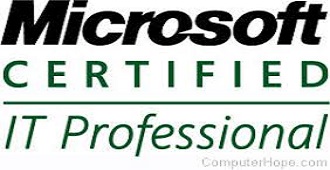Microsoft Certified IT Professional (MCITP) – 130 HRS
Microsoft Certified IT Professional (MCITP)
Duration: 130 h – (5level)
Administrator certification in Windows 2008 is provide to your current and future employers that you have the skills and knowledge to implement and maintain a Windows Server 2008 network infrastructure. People who hold a MCITP Enterprise Administrator certification have one of the highest salaries on average compared to other MCITP certifications.
Level1: Windows Server 2008 Active Directory, Configuring
Module 1: Introducing Active Directory Domain Services.
Module 2: Administering Active Directory Securely and Efficiently.
Module 3: Managing Users and Service Accounts.
Module 4: Managing Groups.
Module 5: Managing Computer Accounts.
Module 6: Implementing a Group Policy Infrastructure.
Module 7: Managing User Desktop with Group Policy.
Module 8: Managing Enterprise Security and Configuration with Group Policy Settings.
Module 9: Securing Administration.
Module 10: Improving the Security of Authentication in an AD DS Domain.
Module 11: Configuring Domain Name System.
Module 12: Administering AD DS Domain Controllers.
Module 13: Managing Sites and Active Directory Replication.
Module 14: Directory Service Continuity.
Module 15: Managing Multiple Domains and Forests.
Level2: Windows Server 2008 Network Infrastructure, Configuring
Module 1: Planning and Configuring IPv4.
Module 2: Configuring and Troubleshooting DHCP.
Module 3: Configuring and Troubleshooting DNS.
Module 4: Configuring and Troubleshooting IPv6 TCP/IP.
Module 5: Configuring and Troubleshooting Routing and Remote Access.
Module 6: Configuring, and Troubleshooting the Network Policy Server Role Service.
Module 7: Implementing Network Access Protection.
Module 8: Increasing Security for Windows Servers Security is an essential consideration for networking with Windows Server 2008.
Module 9: Increasing Security for Network Communication.
Module 10: Configuring and Troubleshooting Network File and Print Services.
Module 11: Optimizing Data Access for Branch Offices.
Module 12: Controlling and Monitoring Network Storage.
Module 13: Recovering Network Data and Servers.
Module 14: Monitoring Windows Server 2008 Network Infrastructure Servers.
Level3: Windows Server 2008 Applications Infrastructure, Configuring
Module 1: Installing and Configuring Microsoft Windows Server 2008 R2.
Module 2: Implementing Deployment Technologies.
Module 3: Using Windows Deployment Services.
Module 4: Implementing the Microsoft Deployment Toolkit.
Module 5: Migrating Active Directory Service.
Module 6: Migrating File, Print, and Web Services.
Module 7: Deploying Branch Office and Remote Access Services.
Module 8: Migrating Workloads to Microsoft Virtual Machines.
Level4: Windows Server 2008, Enterprise Administrator
Module 1: Designing IP Addressing and Configuration.
Module 2: Designing Name Resolution.
Module 3: Designing Advanced Name Resolution.
Module 4: Designing Network Access.
Module 5: Designing Network Security.
Module 6: Designing Application Deployment.
Module 7: Designing Remote Desktop Services.
Module 8: Designing Internet Information Services for Web-Based Applications.
Module 9: Designing File and Print Services.
Module 10: Designing File Replication and Caching.
Module 11: Designing for Business Continuity.
Module 12: Designing a Server Virtualization Infrastructure.
Module 13: Designing an Update Deployment Strategy.
Level5: Windows 7, Configuring
Module 1: Installing, Upgrading, and Migrating to Windows 7.
Module 2: Configuring Disks and Device Drivers.
Module 3: Configuring File Access and Printers on Windows 7 Client Computers.
Module 4: Configuring Network Connectivity.
Module 5: Configuring Wireless Network Connections.
Module 6: Securing Windows 7 Desktops.
Module 7: Optimizing and Maintaining Windows 7 Client Computers.
Module 8: Configuring Mobile Computing and Remote Access in Windows 7.

